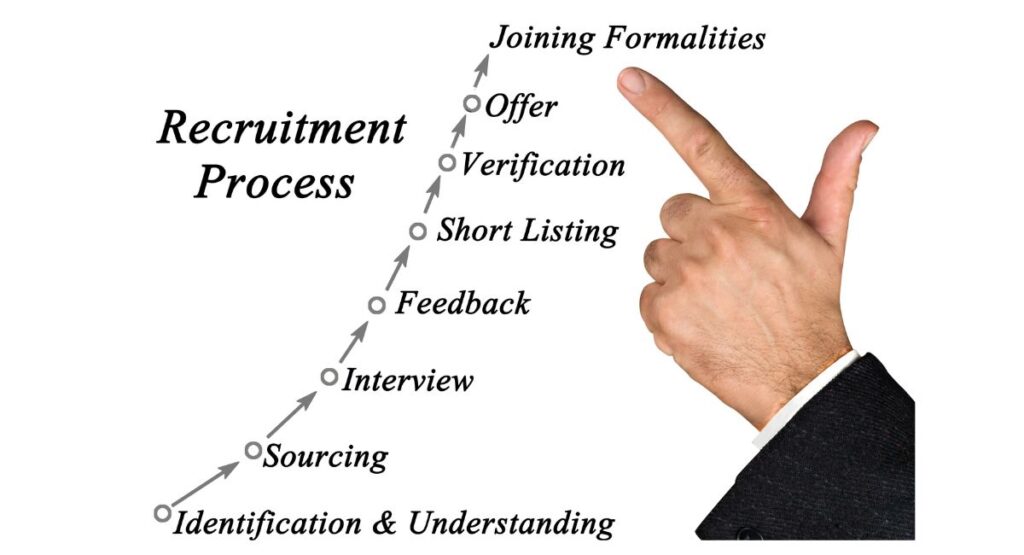In today’s fast-paced business scenario, right talent hire has moved from being just a necessity to being a strategic necessity. The growing demands have made companies hire 360 recruitment that covers all the hiring cycle from sourcing to onboarding in order to ensure consistency and meet better candidate experience with coordination with the organization’s goals.
To achieve exceptional results in 360 recruitment, partnering with the best HR consultancy can be the differentiator for your organization’s success by the end of 2025. Mastering effective 360 recruitment strategies ensures a competitive edge in your hiring process. Let’s explore how to get there.
- What is 360 Recruitment?
- Advantages of 360 Recruitment
- Challenges in 360 Recruitment
- 180 vs. 360 Recruitment: A Comparative Analysis
- Top Strategies for Successful 360 Recruitment in 2025
- How Technology Can Leverage the 360 Recruitment Process
- Role of Employer Branding in 360 Recruitment
- Clavius Solutions: Your Strategic Ally in 360 Recruitment
- Final Thoughts
- FAQs on 360 Recruitment
What is 360 Recruitment?

360 recruitment or full-cycle recruitment refers to the whole cycle where one person recruiter deals with all the strides of the recruitment process. These often include the following process:
- Identification & Understanding
Identify the requirements of the role and understand the ideal candidate’s profile. This stage sets the foundation for the recruitment process. - Sourcing
Locate potential candidates through various channels like job boards, referrals, or social media. Effective sourcing ensures a diverse and qualified talent pool. - Interview
Conduct structured interviews to assess candidates’ skills, qualifications, and cultural fit. This step helps narrow down the best-suited applicants. - Feedback
Gather insights and opinions from interviewers to evaluate candidates comprehensively. Timely feedback accelerates the decision-making process. - Short Listing
Create a list of the most qualified candidates based on interviews and evaluations. This stage ensures only the top talent moves forward. - Verification
Perform background checks and verify references to ensure the candidate’s credentials and integrity. It’s a critical step to mitigate hiring risks. - Offer
Extend a formal job offer outlining salary, benefits, and terms of employment. Clear communication at this stage ensures mutual understanding. - Joining Formalities
Complete onboarding tasks, including documentation and induction programs. A smooth transition ensures the candidate integrates seamlessly into the organization.
Unlike any other fragmented approach requiring multiple people or teams, 360 recruitment guarantees consistency and reliability since it involves one person who is answerable to the entire process.
Advantages of 360 Recruitment
Adopting the 360 recruitment model provides so many benefits:
a. Consistency
A single contact is ensuring streamlined communication with no overlap or confusion in the hiring process. This leads to clarity and consistency for both candidates and stakeholders, hence making the whole process more efficient.
b. Improved candidate exprience
Since personalized interaction characterizes every step of the process, candidates feel that value and respect for them, thereby improving perception for your company. A hiring process that runs smoothly and seamlessly protects the employer brand while building loyalty and trust.
c. Productivity
By integrating the stages of recruitment, delays and misunderstandings are eliminated, which facilitate streamlined hiring procedures. This way, efficiency enables recruiters to focus on strategic work, thus strengthening the recruitment cycle itself.
d. Better Stakeholder Relationship
Close collaboration between recruiters and hiring managers builds trust, ensuring alignment with organizational objectives. Regular communication enhances relationships; hence, better placed to achieve more tailored and successful hiring outcomes.
e. High Quality Recruitment
That is to say, recruiters really get a fantastic understanding of job roles and company culture, which helps them identify the most eligible candidates. In this way, holistic oversight ensures better matches, contributing to long-term employee retention and satisfaction.
f. Cost Cutting
The process of recruiting employees reduces unnecessary steps and redundancies, reflected directly in lower operational costs. A standardized approach achieves lower resource usage for recruitment, so it is cost-efficient for all businesses.
Additionally, aligning your recruitment strategy with the organization’s performance appraisal policy can lead to better workforce management and employee retention. By ensuring that new hires understand performance expectations and growth opportunities from the outset, organizations can foster a culture of accountability and long-term success.
Challenges in 360 Recruitment

360 Recruitment has many benefits but has its downsides as well:
a. Time-Consuming
Managing the entire recruitment cycle can be overwhelming, especially for recruiters handling several roles concurrently.
b. Scalability Issues
While in big organizations with many recruitment needs, one recruitment officer will become overwhelmed by so many existing vacancies.
c. Risk of Bias
Also, unconscious biases can slip in when one person manages the hiring process.
The challenges thus require strategic planning in concert with supportive tools and practices.
180 vs. 360 Recruitment: A Comparative Analysis
Understanding the difference between 180 and 360 recruitment can help businesses choose the right model for their hiring needs.
| Aspect | 180 Recruitment | 360 Recruitment |
| Scope | Focuses on either sourcing or hiring. | Covers the entire hiring cycle. |
| Accountability | Limited to specific stages of the process. | Full accountability from start to finish. |
| Candidate Experience | Can feel fragmented due to multiple touchpoints. | Provides a seamless and personalized experience. |
| Efficiency | May require coordination among multiple recruiters. | Streamlined under a single recruiter. |
| Best Suited For | High-volume or specialized hiring. | Strategic, high-impact roles. |
Top Strategies for Successful 360 Recruitment in 2025

One can do the following to flour1. Utilize Data Analytics
Good recruitment operations make decisions based on data. Therefore, analytics should be utilized to measure metrics such as time-to-hire, cost-per-hire, and candidate satisfaction. For instance, knowing the bottlenecks in the process helps in refining it to ensure efficiency increase.
Tip: Invest in an Applicant Tracking System (ATS) with advanced analytics capabilities to gain actionable insights.
2. Prioritize Candidate Experience
Candidate experience will remain an important differentiator in 2025 for securing the top talent. Clear communication, on-time updates, and hence, a personalized approach to one’s life cycle, will really make an outsider see your organization in a positive light.
Tip: Use feedback surveys from candidates to find areas of improvement and tune your approach.
3. Establish a Talent Pipeline
Proactive sourcing minimizes time-to-hire and also pools a consistent pipeline of qualified candidates. Recruit talent through networking events, social media, and talent communities even when not hiring currently.
Tip: Hold an active database of passive candidates who may match your organization’s future needs.
4. Develop stakeholder relationships
Use AI-based tools for non-IT recruitment, automation, and analytics to streamline sourcing, screening, and scheduling. Regular check-ins ensure mutual understanding and foster trust.
Tip: Meet bi-weekly to review progress, discuss concerns, and make fine-tuning adjustments on strategies.
5. Feature Technology
Use AI-based tools and automation in recruitment to help automate or even simplify tasks as simple as sourcing, screening, and scheduling interviews.
Tip: Use algorithms of machine learning to identify candidates fitting the job description and the culture.
6. Employer Branding as Key Conclusion
A strong employer brand attracts top talent and reduces hiring costs. Showcase your company culture, values, and employee success stories across platforms.
Tip: Persuade employees to write realistic reviews on platforms such as LinkedIn and Glassdoor.
7. Standardize the Interviewing Process
Unstructured interviews can lead to inconsistent evaluations and biases. A structured approach ensures fairness and enables objective assessment.
Tips: Use interview scorecards in judging candidates against often set standards.
8. Conduct Thorough Reference Checks
Thorough reference and background checks are essential to validate candidate credentials and align their values with your organization’s.
Tips: Partner with trusted authenticating firms to do a less hassle job. Verify candidates’ credentials through a reliable manpower consultancy or professional job consultancy services in 360 recruitment:
How Technology Can Leverage the 360 Recruitment Process

Technology will shape recruitment in 2025 in monumental ways. This is how technology will amend 360 recruitment:
• AI-Based Sourcing: This allows using AI tools to analyze massive pools of talent and select the best candidates based on specific criteria.
Video Interviewing. Virtual video interviews save time and other relevant resources without jeopardizing the recruiting process.
• Onboarding Platforms: Digital onboarding solutions ensure new hires feel welcomed and prepared from day one.
Here is how technology can help recruiters streamline workflows, make candidate experiences better, and optimize hiring results.
Role of Employer Branding in 360 Recruitment
A strong employer brand can attract and retain the best staff. Highlight your organization’s USPs and provide an inclusive workplace culture that the people in your organization will engage with.
Tip: Publish regular updates about the company’s achievements, employee successes, and worksite initiatives to demonstrate credibility and attract talent.
Clavius Solutions: Your Strategic Ally in 360 Recruitment
We know recruitment is the backbone of most organisational success; this is why we have such expertise in 360 recruitment-to ensure that your hiring process is nothing but thorough, efficient, and fashioned to meet your business needs. Here’s how we can help:
- Simplified Recruitment Process
Clavius Solutions manages the entire recruitment cycle, from sourcing to onboarding, for consistency and a smooth experience in handling candidates. You can save quite some time and resources while achieving the best results with us.
- Better Candidate Engagement
Our culture-centric approach to interactions builds trust and strengthens your employer brand. This we do through effective two-way communication and keeping candidates clear and valued, more likely to join your company.
- Data-Driven Hiring
With advanced analytics and AI-powered tools, we ensure optimization at all recruitment process stages, starting from sourcing high-potential candidates, reducing time-to-hire, and gathering data-driven insights that translate into measurable results.
- Building a string stakeholder relationship
We work closely with your hiring managers to understand the specific requirements and align our strategies with your organizational goals and ensure trust by providing customized recruitment solutions through building mutual cooperation.
- Employer Branding
Clavius Solutions can help strengthen your employer brand through effective storytelling and reputation management. You can highlight your unique value proposition, making your organization a desirable destination for the best and brightest.
- Cost-Effective Solutions
Our processes eliminate redundancies, so your recruitment investments are optimized. It delivers superior hires through a focus on quality and efficiency, which lowers your overall hiring costs. Partner with Clavius Solutions to tap the 360 recruitment potential. Let’s transform your hiring process into strategic business growth. Make that call today and raise the bar on your recruitment!
Final Thoughts
Changes in the business environment call for changes in recruitment strategies. A 360-degree approach can thus present a well-rounded solution to the modern dilemmas of efficiency and quality, with excellent candidate experience. Using the above strategies, organizational structures will be better prepared to succeed in 2025 and beyond.
Are you ready for a revolution in the hiring process? Stay tuned for more information and strategies on how to elevate your recruitment game and transform your way of talent acquisition!
FAQs on 360 Recruitment
Q.1.What is the 360 model of recruitment?
The 360 model of recruitment, also known as full-cycle recruitment, involves a single recruiter managing all stages of the hiring process. This includes sourcing, screening, interviewing, selecting, and onboarding candidates, ensuring consistency and accountability.
Q. What is the difference between 360 and 180 recruitment?
The 360 recruitment model covers the entire hiring process, while 180 recruitment focuses only on one aspect, such as either sourcing candidates or managing the interview and onboarding stages. The former offers a holistic approach, whereas the latter splits responsibilities between different specialists.
Q.3. What are the duties of 360 recruitment?
A 360 recruiter handles sourcing candidates, conducting interviews, coordinating with hiring managers, negotiating offers, and ensuring smooth onboarding. Their role encompasses end-to-end management of the recruitment process to align with business goals.
Q.4. What is a full-desk 360 recruiter?
A full-desk 360 recruiter manages both client relationships and candidate placements. They act as a bridge between companies and potential hires, overseeing every step from understanding job requirements to finalizing employment terms.
Q.5 What is the 360 recruitment process?
The 360 recruitment process begins with identifying job vacancies and sourcing candidates, followed by screening, interviewing, and selecting the right fit. It concludes with onboarding and integrating the new hire into the organization.
Q.6. What is a 360 deal in recruitment?
A 360 deal in recruitment refers to a comprehensive agreement where the recruiter is responsible for managing every aspect of the hiring process. This includes client management, talent acquisition, and ensuring the candidate’s smooth integration into the organization.


